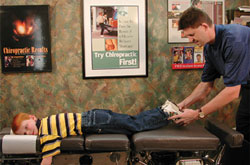Scoliosis and the Chiropractic Lifestyle
Scoliosis is more often seen in girls.
It is thought that scoliosis is the result of a hereditary problem or an adaptation to some type of trauma, such as the birth process, or an injury, such as falling off a bicycle. It usually starts with problems in the lower back.
Because spinal bones continue to grow well into the early 20s, if left uncorrected, scoliosis often worsens.
 Regular chiropractic examinations can reveal small problems before they become serious.
Regular chiropractic examinations can reveal small problems before they become serious.If detected early enough, chiropractic doctors have had excellent success with scoliosis cases.
Unfortunately, the most common treatment approach has been to wait and see how bad it gets, resorting to unsightly braces, or eventually surgery, if it progresses too far.
The chiropractic approach is to use specific spinal adjustments, often combined with
corrective exercises. If detected early enough, chiropractic doctors have had excellent success with scoliosis cases.
Early detection and chiropractic correction is important for optimum results. Do you know someone who could benefit from a chiropractic examination?
What is scoliosis?
Scoliosis is a sideways curving of the spine that often gets started in childhood, when the bones of the spine are still growing. In many cases, the exact cause of scoliosis is unknown.
Scoliosis is detected by uneven shoulder heights, a loss of structural balance, or a change in posture.
Scoliosis is usually detected from a low shoulder, revealing a sideways curvature of the spine.
THE CHIROPRACTIC LIFESTYLE
Chiropractors are experts in the care of the bones, nerves, muscles and connective tissues that make up about 60% of your body. All of the joints in your body are part of this musculo-skeletal system and its optimal function is necessary for overall good health. Ask your Doctor of Chiropractic for more information about a care program that may include specific spinal adjustments, exercise recommendations, nutritional advice or other conservative methods of care based on your health history, age, current
condition and lifestyle.
REFERENCES:
Anrig, C., D.C., Plaugher, G., D.C., Pediatric Chiropractic, 16:646, Williams and Wilkins, 1998.
Aspergren, D., D.C., Cox, J., D.C., Correction of Progressive Idiopathic Scoliosis Utilizing Neuromuscular Stimulation and Manipulation; A Case Report, JMPT, 10: 147-156, 1987.
Cox, J., D.C., Low Back Pain, Mechanism, Diagnosis and Treatment, 5th edition, 309-338, Williams and Wilkins, 1990.
Greenman, P., D.O., Principles of Manual Medicine, p. 207, 2nd edition, Williams and Wilkins, 1996.
Kessler, R., Hertling, D., Management of Common Musculoskeletal Disorders, 587-588, 3rd edition, Harper and Row, 1996.
Maigne, R., M.D., Diagnosis and Treatment of Pain of Vertebral Origin, 128-132, Williams and Wilkins, 1995.
Moore, K., PhD., Clinically Oriented Anatomy, 326-327, 3rd edition, W.B. Saunders Company, 1992.
Plaugher, G., D.C., Anrig-Howe, C., D.C., Textbook of Clinical Chiropractic, 266-278, Williams and Wilkins, 1993
White, A. A., M.D. and Panjabi, M.M., PhD., Clinical Biomechanics of the Spine, 2nd edition, 146-154; J. B. Lippincott Company, 1990.
©2002 Back Talk Systems, Inc.
(800) 937-3113 (303) 277-9990
www.backtalksystems.com
(800) 937-3113 (303) 277-9990
www.backtalksystems.com

